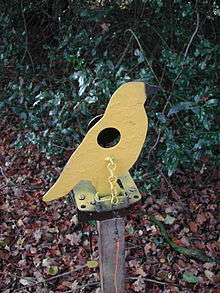Hunter Field Target
Hunter field target (HFT) is a target shooting sport derived from air gun hunting shooting disciplines. It is mainly an outdoor sport practiced with air rifles equipped with optical sights. The rifles have a maximum energy of 16.3 J (12.0 ft⋅lbf).

The hunter field target discipline can be defined as a traveling hunting simulation. A typical match consists of 30 to 40 targets placed at unknown distances to the shooter between 8 to 42 m (8.7 to 45.9 yd). Each target lane consists of a peg, as well as a metal knock-down target placed in a position to simulate a hunting scenario. The peg marks the point of fire, and while firing the shooter must touch the peg with either a part of their body or rifle. The time starts as soon as the shooter touches the peg.
During the match, shooters are not allowed to use supplementary technology, they may not adjust the zoom of the scope, adjust their scope turrets or use any other tools to detect the angle of the rifle and distance to the targets.
There are 3 official shooting positions in the hunter field target:
- Standing position.
- Kneeling position.
- Prone position.
Hunter field target is normally practiced in wooded areas or open countryside and in any weather conditions.
Equipment
A typical HFT rifle set-up consists of an air rifle fitted with a telescopic sight. The rifle can vary from the very basic break-barrel spring-powered rifle to the most advanced electronic recoil-less pre-charged pneumatic (PCP) rifle. The most popular calibre for HFT is 4.5 mm (.177 inches) because of its flat trajectory,[1] and telescopic sights capable of 10× magnification are favored. The maximum output power of the rifle must be limited to 16.3 joule.
Participants in HFT competitions may compete in different categories, such as Recoiling, Open and .22. and there are different categories for children and young people.
| Class | Description |
|---|---|
| Open | Any shooter. Primarily contains shooters using pre-charged pneumatic rifles (PCP) in 4.5 or 5.5 mm (0.177 or 0.217 in) calibre. |
| Junior | Shooters aged between 9 and 16 years. (Can be further divided into separate classes for 9-13 and 14-16 years). |
| Recoiling | Spring-powered or gas-ram air rifles (any calibre). |
| 22 | Any rifle in 5.6 or 6.4 mm (.22 or .25 in) calibre. |
References
- "Ballistics Explained". fekete-moro.hu. Retrieved 15 August 2014.